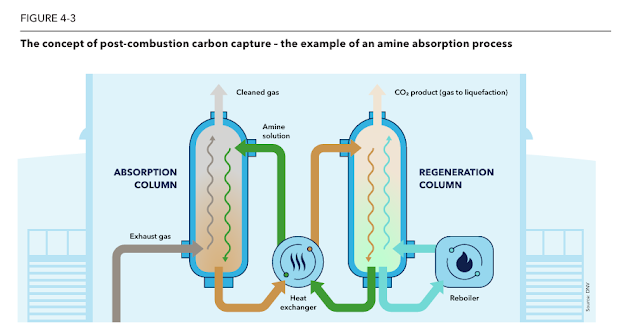Onboard carbon capture and storage systems (OCCSSs) are an
emerging method of decarbonizing shipping. Hydrogen, methanol, and ammonia are
expected to compete for powering ships with reduced carbon footprints. DNV
explains onboard carbon capture:
“Onboard carbon capture (OCC) covers a range of
technologies to capture carbon dioxide emissions from ships during operation.
For post-combustion systems, OCC involves cleaning of exhaust gases from CO2,
separating it, and storing it onboard for eventual offloading, in various
different forms depending on the technology (gas, liquid, or mineral). For
pre-combustion, carbon is separated from the fuel to produce hydrogen and use
it in dedicated energy conversion machinery.”
DNV has a great white paper
on OCCSSs. They note that ideally, an OCCSS should be incorporated into new
ship builds rather than retrofitted. This is because space on the ship must be
carefully organized, and its safety maximized. It is also more expensive to
retrofit. DNV, which has been working with OCC since 2009, notes:
“A scaling of the CCUS infrastructure network, across
geographies and nations, will establish the grounds for uptake of onboard
carbon capture technology. As of today, this infrastructure is not established.
The shipping industry needs to reach out to relevant CCUS development projects
near major shipping hubs to discuss how the maritime industry can connect to
the wider CCUS value chain.”
They also point out the
importance of after-treatment and compare it to the SOx scrubbers utilized
after the 2020 sulfur rules for ships went into effect.
“Shipping companies will aim to ensure compliance
through effective combinations of decarbonization options: carbon-neutral
fuels, energy-efficiency improvements, operations optimization, and onboard
carbon capture. Similar to what happened in the 2020s with the global sulphur
cap, the after-treatment of carbon emissions is expected to be relevant for
both existing ships and newbuilds.”
An important consideration is
that carbon capture systems use fuel to run them, and that fuel must be
accounted for in decarbonization accounting, cost analysis, and overall ship
energy systems. The availability of disposal systems for the captured CO2 is
another important consideration. Offshore wells are being outfitted for carbon
sequestration in many places, so that will likely be a main route for disposal.
DNV lists five steps of the
OCCSS value chain: 1) onboard capture, 2) onboard storage, 3) offloading, 4)
transportation, and 5) permanent storage or utilization.
Product specifications and
purity requirements must be met for offloading. Ports around the world must be
coordinated with CCUS projects around the world to minimize CO2 transport
costs. Different methods of carbon capture are summarized in the graphics
below.
They note that the capture
rate must be balanced against the fuel penalty.
“The fuel penalty depends on the type and performance of
the capture technology, as well as the ship’s operating profile and engine
load. The trade-off between high capture and low fuel penalty is one of the
main challenges of onboard carbon capture, as it affects both the environmental
and economic viability of the technology. Systems operating with a high capture
rate may have excessive energy demands, making them less feasible from an
operational and cost perspective.”
Cost analysis is very important for these projects. Ships that run on LNG can have some advantages in coordinating processes such as liquefaction and can implement smaller capture systems, saving energy and space. Cost must be balanced with decarbonization goals.
Regulations vary by
region and include GHG regs, safety regs, and waste handling regs. These are
summarized below.
Other practical
considerations are noted in the graphics below, including onboard positioning
and the different needs for different types of ships. The extra weight of the
CO2 and its capture and storage system is also a consideration.
Shanghai Qiyao Environmental Technology Conducts First
Ship-to-Ship Liquefied CO2 Transfer
Shanghai Qiyao Environmental
Technology (SMDERI-QET) recently conducted the world’s first ship-to-ship
liquid CO2 transfer at the Yangshan Deep-Water Port in Shanghai. Global Data
explains:
“This transfer demonstrates an end-to-end solution
comprising onboard carbon capture, liquefaction, storage, and offloading to
carbon utilisation facilities.”
“SMDERI-QET's Onboard Carbon Capture and Storage System
(OCCS) has achieved more than an 80% capture rate of carbon dioxide with a
99.9% purity level.”
“Since delivering the first full-process OCCS in early
2024, SMDERI-QET has completed several LCO₂ offloading projects, enabling ship
owners to improve their Carbon Intensity Indicator (CII) ratings.”
The company noted that the
lack of port infrastructure capable of managing large-scale carbon storage and
recovery has hindered their ability to offload more ship-to-shore LCO2. They
noted that:
“…transferring LCO₂ from ship to ship greatly enhances the
adaptability of operations, allowing for efficient loading and unloading for
ships at terminals that may lack the necessary facilities.”
They plan to collaborate with
domestic and international partners to help develop regulations and standards
for marine carbon capture and transportation.
SMDERI-QET's general manager,
Su Yi, noted:
“We are confident that the completion of the world’s
first ship-to-ship LCO₂ transfer, together with the further development of
onboard carbon capture technologies, will not only lead to rapid development of
a global network of shore-based carbon storage and utilisation facilities, but
accelerate the decarbonisation of shipping.”
References:
SMDERI-QET
successfully conducts world’s first ship-to-ship LCO₂ transfer. GlobalData.
June 27, 2025. SMDERI-QET
successfully conducts world’s first ship-to-ship LCO₂ transfer
Onboard
Carbon Capture and Storage on Ships. Chara Georgopoulou. DNV. Onboard
carbon capture and storage on ships
The Potential
of Onboard Carbon Capture in Shipping. DNV. White Paper. September 2024.
DNV_Onboard_Carbon_Capture_White_paper_24-09_web.pdf

















No comments:
Post a Comment